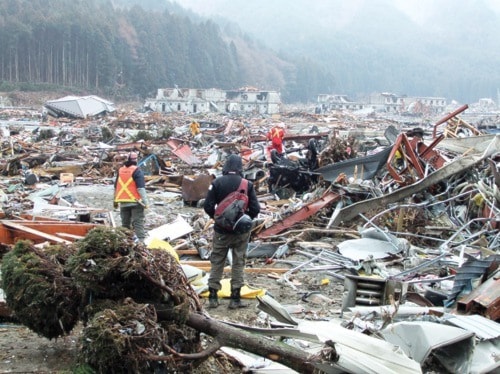It was to be a life changing moment for local resident Seiko Watanabe.
She watched from Burns Lake as the most powerful earthquake in Japanese history rocked her home country.
The following tsunami washed waves of up to 124 feet nearly 10 kilometres inland, washing away entire villages.
Watanabe's brother lives in the Miyagi prefecture near the earthquake's epicentre, but was fortunately in Tokyo at the time. His home was washed away.
More than 2,000 bodies have since been found in this prefecture alone.
Watanabe knew she had to do something.
Her daughter suggested her mom, who is an occupational therapist at College of New Caledonia's Lakes District Campus, should travel to Japan as part of the Canadian Medical Assistance Team (CMAT).
She applied hopeful, but did not think she would be chosen to go. A couple of days later, Watanabe was on her way to Japan as part of CMAT.
Watanabe said she was primarily selected to be a translator for the Canadian team.
"I was not just a language translator but also a cultural translator ... I understood the culture of the area we were traveling to," she said, adding that the area is comprised of small fishing villages and farm lands and was inhabited by very traditional Japanese people.
Once on the ground in Japan, Watanabe was not prepared for the magnitude of destruction that lay at her feet. "None of us were," she said.
Everywhere she looked there was debris, broken wood, twisted metal, shards of glass, children's toys and personal possessions.
A clock which had stopped 10 minutes after the earthquake hit lay intact in the debris.
"I think the clock stopped when the tsunami hit here," said Watanabe looking at the photo she took.
In another picture someone's treasured pearl earrings lay in a blue velvet box amongst the thick mud and debris.
A bus sits perched on top of a two story building pushed up there by the force of the tsunami.
"The images you see on television don't really prepare you for the magnitude of destruction ..... or the smell," she said.
"It is a huge mess and there is a strong sea water and rotting smell," Watanabe added.
Watanabe's CMAT team was on the ground to provide support to teams that were already working. They provided medical care, handed out blankets, warm clothes and set up a water purification system.
"The Japanese defense force were there searching for bodies. They were overwhelmed so we helped them look," she said, adding that there were three bodies pulled from the debris during the time her CMAT team was helping.
"People were living side by side in classrooms, a lot of people were sick, many had developed pneumonia," she said.
Watanabe said she was surprised by the sense of community she found.
"They hold the traditional belief of helping each other .... it's called 'Ganbare!' or Ganbarou! ....... which means let's stick together, hang in there and do your best ..... this is what I noticed," she said.
"People were so thankful that we were there helping, they don't like to ask for help, but in their hearts they needed it, their strength to survive is amazing."
"They are so resilient, that is one thing I noticed, they would collect debris to make a fire to cook with, still cooking in the traditional way despite everything that has happened. They also tried to give us things when they had nothing .... we told them we were not allowed to accept anything, but they would always try ..... it was very moving," she said.
"People I was helping, that had nothing offered me a cup of coffee. I declined telling them I could not accept, however they told me they had large a supply of coffee from a broken vending machine they had found. They were very resourceful," she said.
When Lakes District News asked Watanabe how long she thought it would be before Japan would recover she replied, "It will be forever."
"Japan is used to earthquakes. The houses were still standing after the earthquake, it was the tsunami that did the damage. The area that the earthquake hit has a lot of inlets which worked like funnels to carry the water in and up high," she said.
She also feels much of the initial reporting about the nuclear disaster was just fear mongering.
"Originally there was a 100 kilometre radiation radius set up where people could not enter, now it has been reduced to 20 kilometres but I wish I could have gone into this area. People in this area were not getting any help at all. We had a doctor on our team from Halifax who specialized in radiation which was helpful He gave us good advice and said the radiation levels in the area were too low to be harmful," she said.
According to Watanabe she paid her own way to Japan and the CMAT program is funded by Canadian donations. "We had to be self reliant when we were there, we lived in a tent and it was freezing."
She said the Vineyard Christian Church raised $1,500 for a water purifier which was airlifted to Japan and is in use. "I am so thankful for the support from Burns Lake," she added.
The Canadian Red Cross is still accepting donations. To donate go to www.redcross.ca.
